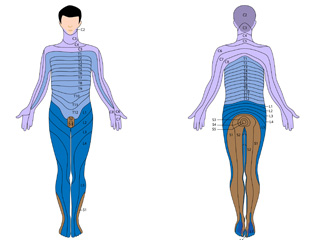Sciatica is a form of low back pain. It is a set of symptoms rather than a diagnosis including pain caused by irritation of the nerve root. People describes it as a severe and peculiar pain that radiates from the lumbar spine running down the back of the leg. It is usually accompa-nied by numbness in toes.
The most frequent causes of sciatica are the spinal disc herniation, which evolves favourably in 95% of cases getting better in 12 weeks and without surgical intervention and the spinal stenosis, which leads to a decrease of the space where nerve roots branch out from the spi-nal cord.
If a sciatica appears, do not panic, it is a benign process indeed and it can be controlled easily with analgesics, antiinflammatories and membrane modules. Symptoms usually disappear in 8-12 weeks, however, there are warning signs that are considered as a medical emergency.
Warning signs:
- Uncontrollable severe back pain in spite of analgesics.
- Paresis. This condition features loss of motion in muscles.
- Loss of bowel control.
In a patient with these signs, magnetic resonance imaging can help with the diagnosis and a decompression surgery may be required urgently.
Further testing should be done to identify the source of pain if symptoms persist after 12 weeks. At present, MRI is the most accurate test to diagnose back problems, but it is some-times advisable to apply for an electromyography (EMG) to check on the state of the sciatic nerve.
If symptoms are caused by a spinal disc herniation with no associated lumbar pain or degene-rative signs shown in the MRI, the patient should go through a discectomy. However, if sciatica presents lower back pain and degeneration, spondylolisthesis or spinal stenosis the pro-cedure must be an arthrodesis (spinal fusion).








